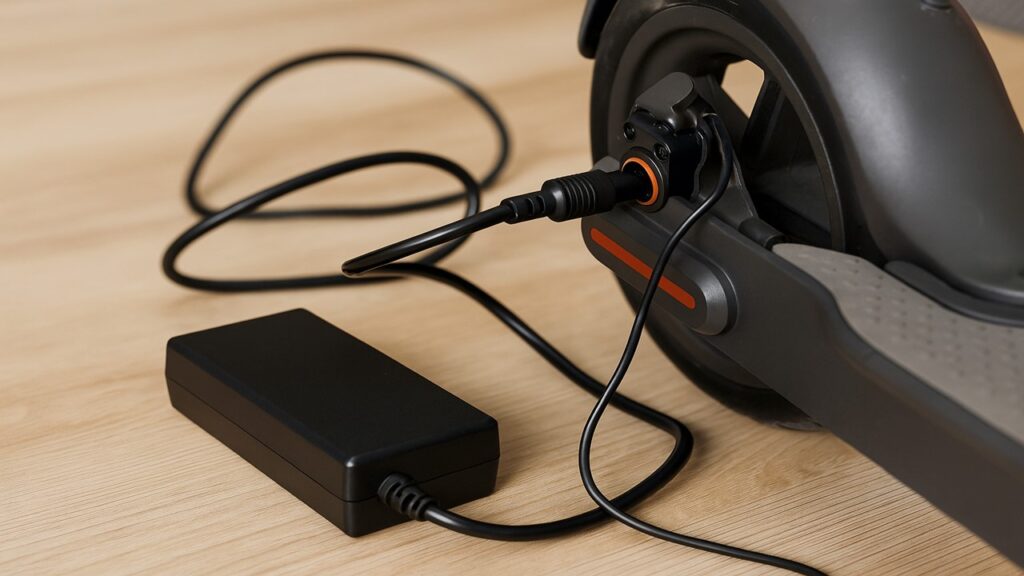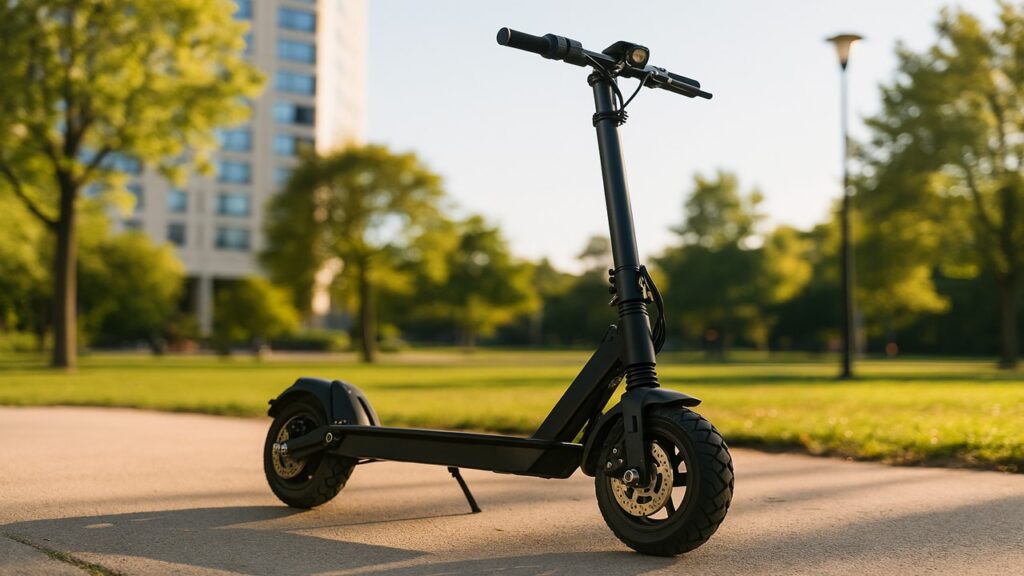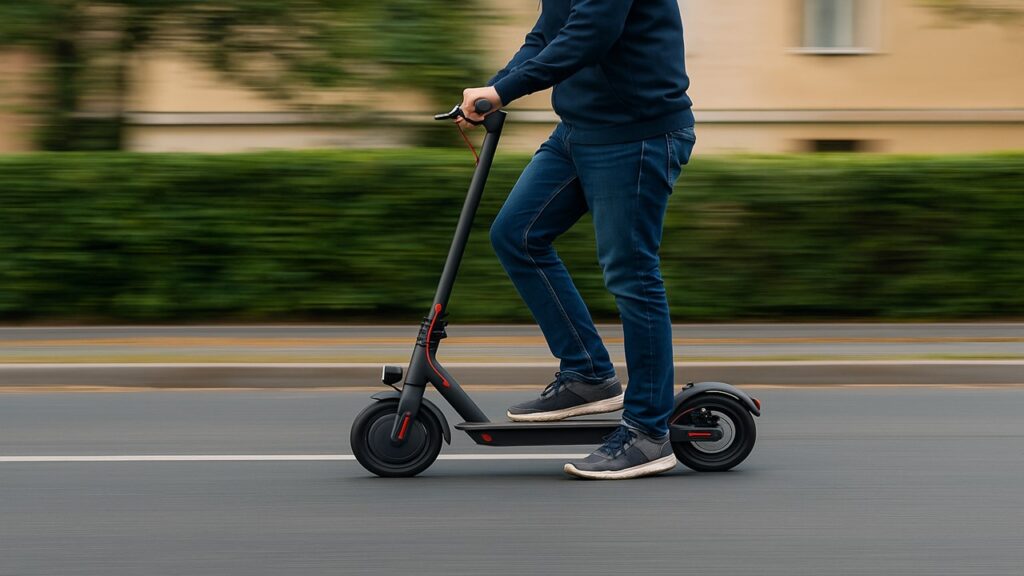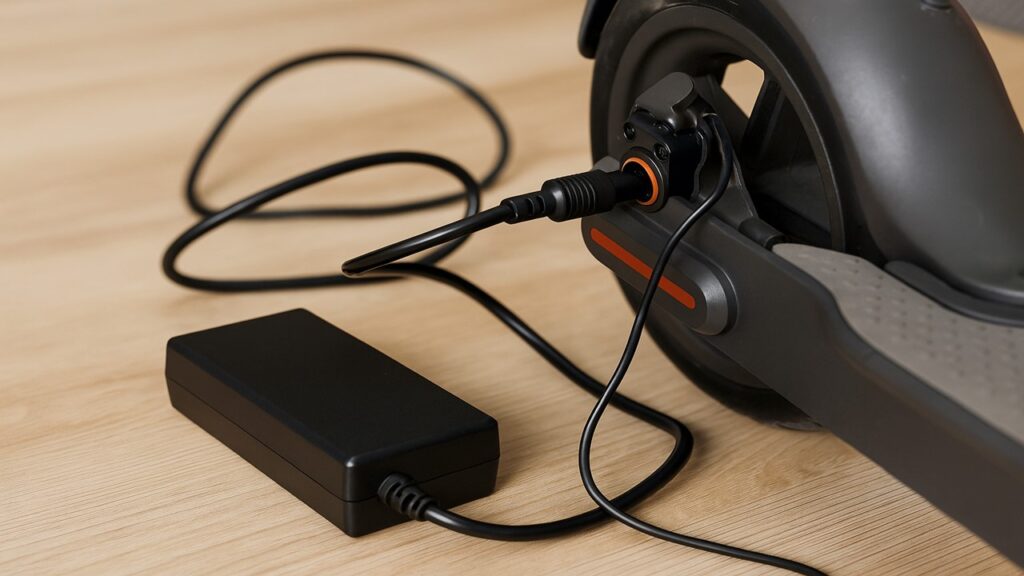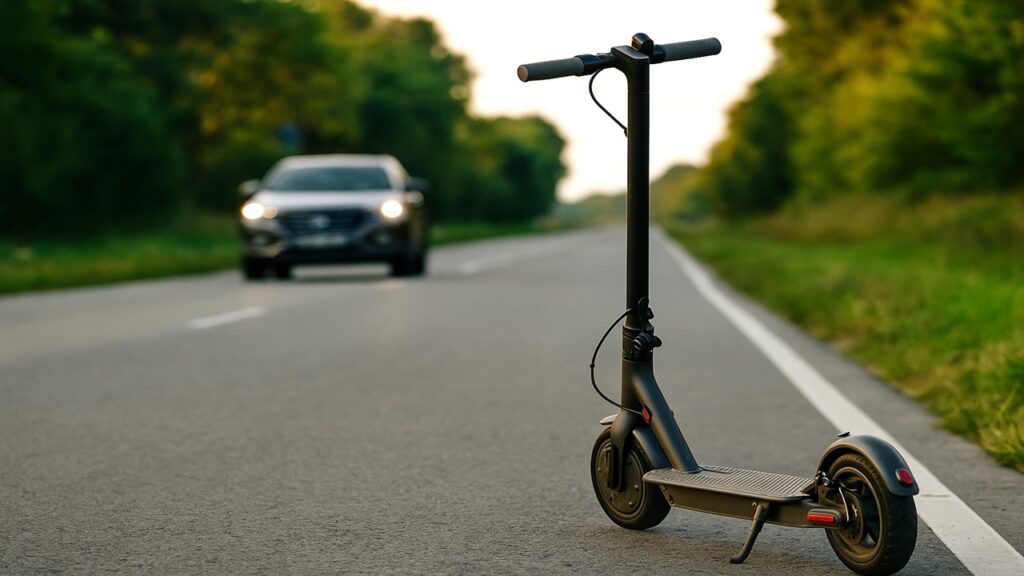
An electric scooter battery typically lasts anywhere from 8 to 40+ miles per charge, depending on the scooter type, battery size, rider weight, terrain, and riding habits. Entry-level models tend to offer shorter ranges, while premium performance scooters can cover long distances on a single charge.
Key Summary:
- Most electric scooters travel 8 to 40+ miles per charge, depending on battery size, model, and riding conditions.
- Rider weight, terrain, speed, and weather all directly affect battery range in everyday use.
- Lithium-ion batteries typically last 300–500 full cycles, or about 2–4 years with normal care.
- Proper charging habits, steady riding, and temperature control can maximize range and extend battery life.
Average Range of an Electric Scooter Battery
The range of an electric scooter battery isn’t fixed — it varies by category. Entry-level scooters usually provide between 8 and 15 miles per charge, commuter models average 15 to 30 miles, and performance scooters can exceed 60 miles under the right conditions.
What matters most is the balance between battery capacity (measured in watt-hours) and the scooter’s energy demands. A higher-capacity pack can store more energy, but it also increases weight and cost.
Chart: Average Range by Scooter Category
| Scooter Type | Typical Range (Miles) | Battery Capacity (Wh) | Charging Time | Price Range |
| Entry-Level | 8–15 | 250–300 | 3–5 hours | $300–$500 |
| Commuter | 15–30 | 350–600 | 5–7 hours | $600–$1,200 |
| Performance | 30–60+ | 700–1600+ | 8–12 hours | $1,200–$3,000+ |
Key Factors That Influence Range
How far you can ride on one charge depends on multiple conditions working together.
Key influencers include:
- Battery size and capacity
- Rider weight and carried load
- Terrain and incline level
- Speed and acceleration patterns
- Temperature and weather conditions
- Tire pressure and scooter maintenance
Each factor changes how efficiently the motor draws energy. Let’s look at them in detail.
Battery Size and Capacity
Battery size is the foundation of an electric scooter’s range. It’s measured in watt-hours (Wh), which represents the total energy stored. A 250Wh battery is common in lightweight, budget scooters designed for short urban commutes of around 8–12 miles. Larger packs, like 500–600Wh, power mid-range commuter scooters, offering 20–30 miles of range. Performance scooters often use 1,000Wh or more, capable of 50–60+ miles if ridden efficiently. The trade-off is weight, cost, and charging time — larger batteries provide longer rides but make the scooter heavier and more expensive.
Rider Weight and Load
The weight of the rider and any carried items directly affects how much power the motor draws. Most scooter manufacturers test range with riders around 150–165 pounds. If you weigh more or carry heavy backpacks or groceries, the battery has to work harder to maintain the same speed. As a rule of thumb, every additional 20–30 pounds can reduce range by 5–10%. That means a scooter rated for 20 miles under test conditions may deliver closer to 16–18 miles for a heavier rider.
Terrain and Road Conditions
Flat, smooth roads allow scooters to run at peak efficiency. But once you introduce slopes or rough surfaces like gravel or cobblestone, the motor must work harder, pulling more energy from the battery. Even a mild incline makes a noticeable difference. On a 10% grade hill, range can drop by 50% compared to flat terrain. Similarly, uneven roads increase rolling resistance, which drains energy faster. Riders in hilly areas often find their real-world range much lower than advertised.
Speed and Riding Style
Battery consumption rises sharply with speed. At moderate cruising speeds (10–15 mph), most scooters achieve their rated range. But riding at top speeds creates significantly more air resistance and motor demand. Aggressive riding habits — like rapid acceleration, frequent braking, or stop-and-go traffic — can cut range by 30–40%. On the other hand, steady speeds and coasting whenever possible help conserve energy.
Weather and Temperature Effects
Temperature plays a major role in battery efficiency. In cold weather (below 40°F or 4°C), lithium-ion chemistry slows down, temporarily reducing capacity by 20–30%. That means a scooter that usually covers 20 miles might only achieve 14–16 miles in winter. Extremely cold conditions (below 20°F or –7°C) can even risk permanent damage if the battery is charged while frozen. Heat doesn’t reduce range immediately, but storing or charging above 90–100°F (32–38°C) accelerates long-term degradation, shortening the overall battery lifespan.
Tire Pressure and Maintenance Habits
Tires are often overlooked, but they make a significant difference in efficiency. Underinflated pneumatic tires increase rolling resistance, forcing the motor to draw more energy to keep the scooter moving. Over time, this reduces both range and battery life. Proper tire pressure ensures smoother rides and better energy use. Regular maintenance — such as checking for brake drag, keeping bearings lubricated, and inspecting electrical connections — also helps maintain efficiency and prevents unnecessary battery strain.
Real-World Examples by Model
Manufacturer specs often look optimistic, but real-world testing tells a more accurate story. For instance, the Xiaomi M365 is rated for 18.6 miles, yet most riders achieve around 12–15 miles depending on weight and terrain. The Segway Ninebot Max advertises 40 miles, but typical use brings it closer to 25–30 miles. Premium models like the Kaabo Wolf King GT can exceed 60 miles, though that drops significantly at top speeds.
Chart: Advertised vs. Tested Range
| Model | Advertised Range | Real-World Range |
| Xiaomi M365 | 18.6 miles | 12–15 miles |
| Segway Ninebot Max | 40 miles | 25–30 miles |
| Kaabo Wolf King GT | 70+ miles | 55–65 miles |
How to Calculate Your Scooter’s Range
You can estimate your scooter’s range with a simple calculation: divide the battery capacity (Wh) by the scooter’s average energy consumption (Wh per mile). For example, a 500Wh battery with a typical consumption of 20Wh per mile delivers roughly 25 miles per charge.
This formula gives you a realistic expectation, but remember that factors like weight, speed, and hills adjust the final number. Using it alongside manufacturer data provides a more reliable picture of what your scooter can do in everyday conditions.
Charging Time and Practices
The time it takes to fully recharge an electric scooter depends mainly on the battery size and the charger’s output capacity. Smaller entry-level batteries (around 250–300Wh) usually recharge in 3–5 hours, while larger commuter packs (350–600Wh) often take 5–7 hours. Performance scooters with over 1,000Wh can need 8–12 hours or more.
Fast chargers reduce waiting time significantly, but they generate more heat, which can shorten long-term battery health if used excessively. Following the manufacturer’s recommended charging guidelines is the safest way to preserve both range and lifespan.
Battery Life in Charging Cycles
Electric scooter batteries are measured in charge cycles rather than years. One cycle equals a full discharge from 100% to 0% and back to 100%. On average, lithium-ion packs last 300 to 500 cycles before their capacity noticeably drops. For a typical commuter who charges a few times per week, this translates into roughly 2–3 years of use.
With proper care, batteries can last longer. If you keep the charge between 20% and 80%, avoid extreme temperatures, and don’t rely solely on fast charging, the cycle life can extend to 500–1,000 cycles, meaning 4 years or more of reliable service.
As the battery ages, you’ll notice gradual changes — reduced range, slower charging, and earlier cutoffs during rides. These signs don’t mean the battery is unsafe, but they show that capacity is no longer at its original level.
Battery Chemistry and Lifespan
Most electric scooters use lithium-ion batteries because they balance energy density with efficiency. Within this category, NMC (Nickel Manganese Cobalt) packs are common for performance models, offering high range but shorter lifespans. LFP (Lithium Iron Phosphate) packs last longer, often exceeding 1,000 cycles, but they’re heavier and usually more expensive.
Emerging technologies such as solid-state and silicon-carbon batteries promise even greater lifespans and faster charging, though these are still limited to high-end or future models.
Signs Your Battery Needs Replacement
Over time, every scooter battery loses capacity. You’ll know it’s time for a replacement when performance becomes unreliable.
Common warning signs include:
- Range drops by more than 30% compared to new
- The battery swells or shows visible deformation
- Excessive heat during charging or riding
- Takes much longer than usual to reach a full charge
- Scooter shuts off unexpectedly during use
If multiple symptoms appear together, replacing the battery is safer than pushing it further.
Battery Replacement and Maintenance Costs
Replacing an electric scooter battery is one of the largest ongoing expenses for ownership. Entry-level scooter batteries usually cost between $150 and $350, including installation. Mid-range commuter models can range from $325 to $625, while performance scooter batteries often exceed $600 and can reach $1,200 or more.
Labor costs also add up. DIY installation can save money if you’re comfortable with electronics, but professional replacement ensures proper installation and avoids warranty issues. Shops often charge $50–150 for the service depending on the scooter’s design.
It’s also worth factoring in warranty coverage. Many manufacturers guarantee battery capacity retention (usually 70–80%) for 1–2 years. If a battery fails early under normal conditions, you may qualify for a replacement at no extra cost. Understanding these terms before you buy can save you hundreds later.
How to Maximize Battery Life Per Charge
Getting the most out of your electric scooter battery is about adopting small, consistent habits that reduce strain and extend range. Simple changes in how you ride and how you charge can add extra miles per trip and help the battery last longer overall.
Practical ways to maximize range:
- Keep the battery between 20% and 80% instead of draining it fully
- Ride at steady, moderate speeds rather than full throttle
- Inflate tires to the recommended pressure to reduce rolling resistance
- Avoid carrying unnecessary weight
- Store and charge the scooter in moderate indoor temperatures
- Use the original charger provided by the manufacturer
Performance in Different Weather Conditions
Weather conditions can change how efficiently a scooter battery performs. Cold, heat, and humidity all affect range differently, and knowing what to expect helps you ride safely without surprises.
Weather effects and how to handle them:
| Condition | Effect on Range & Battery | Recommended Action |
| Cold (<40°F / 4°C) | 20–30% temporary range drop | Store indoors, warm battery before riding |
| Extreme Cold (<20°F / -7°C) | Up to 50% loss, charging damage risk | Avoid charging until warmed, ride gently |
| Hot (>90°F / 32°C) | Slight range loss, faster long-term degradation | Charge during cooler hours, keep scooter shaded |
| Extreme Heat (>105°F / 40°C) | Safety cutoffs or accelerated damage | Avoid use and charging, allow cooling time |
| Rain/High Humidity | 5–15% efficiency loss, risk of water ingress | Ensure seals are intact, dry before storage |
Final Words
Electric scooter batteries typically deliver 8 to 40+ miles per charge, but real-world range depends on weight, terrain, speed, and weather. Entry-level models serve short commutes, while high-capacity scooters stretch to long-distance rides.
To extend your battery’s performance, focus on good charging practices, ride at moderate speeds, and protect the battery from extreme temperatures. With proper care, most lithium-ion packs provide 2–4 years of dependable use before needing replacement.
Understanding these factors ensures you get the most value out of your scooter and avoid unexpected cutoffs mid-ride.
FAQs
How far can an electric scooter go on one charge?
Most scooters travel 8 to 40+ miles per charge, depending on battery size, rider weight, terrain, and speed.
How many years does an e-scooter battery last?
With average use, a lithium-ion battery lasts 2–4 years or 300–500 charge cycles before losing significant capacity.
Can you upgrade an electric scooter battery for more range?
Some scooters support upgrades or external packs, but compatibility, space, and warranty limitations need to be checked first.
Why is my scooter’s range shorter than advertised?
Manufacturers test under ideal conditions. Real-world factors like rider weight, hills, and weather usually reduce range.
How should I store my scooter battery in winter?
Keep it indoors at room temperature, avoid full discharge, and recharge to around 50–70% if stored for long periods.

At our core, we’re a group of passionate scooter enthusiasts. We dive deep into the world of tech, especially when it’s about your everyday usable scooters to make riding convinient. We try to provide as much value to the readers with our information and how to blog articles as possible. We take great satisfaction in offering unbiased evaluations, ensuring that you can make informed decisions when investing in your desired scooters and riding equipments.






